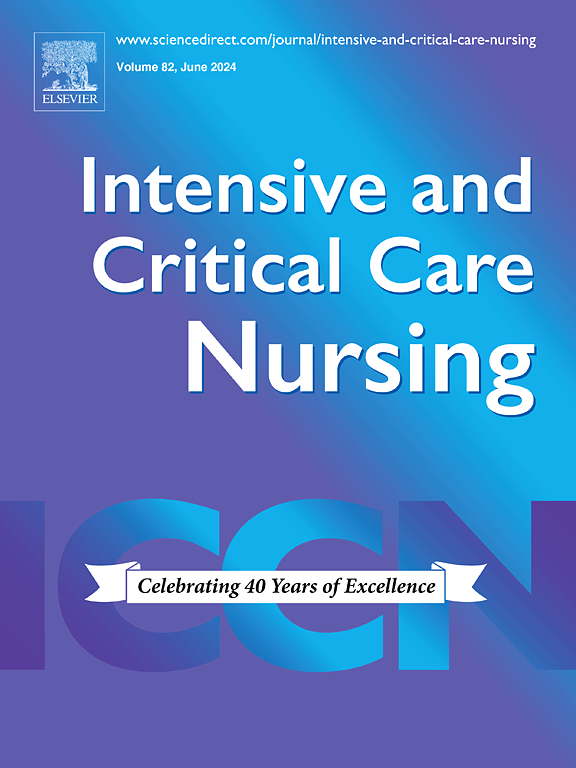体外膜氧合与日间镇静:一项通气患者的比较回顾性研究
IF 4.9
2区 医学
Q1 NURSING
引用次数: 0
摘要
背景:镇痛药的日变化可能使患者预后恶化。然而,没有数据报道接受体外膜氧合(ECMO)的患者的日变化。目的比较成人机械通气患者与ECMO患者镇痛镇静剂量的日变化。设置5个icu(65张床位),包括一个ECMO单元,患者招募时间为2021年7月至2023年7月。方法回顾性单中心队列研究,纳入年龄≥16岁接受持续静脉注射(IV)阿片类药物(芬太尼)和/或镇静剂(咪达唑仑和/或异丙酚),接受机械通气伴或不伴ECMO的患者。我们收集了从07:00至18:59(白天)或19:00至06:59(夜间)持续48小时的所有静脉镇痛镇静剂量(不包括丸剂)的数据。166例(13.0%)接受ECMO, 1111例(87.0%)未接受ECMO。多数为男性815例(63.8%),中位(四分位间距(IQR))年龄58(42-70)岁。我们发现ECMO患者镇痛镇静剂量无日变化。然而,我们发现芬太尼剂量较高(平均差异为1.7 μg/kg, 95%置信区间(CI): 1.0, 2.4 μg/kg, p <;0.001)和异丙酚(平均差2.3 mg/kg, 95% CI: 1.7, 2.9 mg/kg, p <;0.001),与非ecmo患者的白天相比。与非ECMO组相比,ECMO患者接受神经肌肉阻断药物的比例更高,分别为120(72.3%)和138 (12.4%);p & lt;0.001.结论非ecmo患者夜间芬太尼和异丙酚静脉输注剂量较高。然而,我们发现ECMO患者的镇痛镇静剂量没有昼夜变化,这很可能是由于深度镇静和使用神经肌肉阻断药物。对临床实践的影响患者因素、危重疾病因素和ICU入院类型可能是影响ECMO和非ECMO人群镇痛镇静剂量日变化差异的因素。本文章由计算机程序翻译,如有差异,请以英文原文为准。
Extracorporeal membrane oxygenation and diurnal analgosedation: A comparative retrospective study in ventilated patients
Background
Diurnal variation of analgosedation may worsen patient outcomes. However, there is no data reporting diurnal variation in patients receiving extracorporeal membrane oxygenation (ECMO).
Objectives
To compare diurnal variation of analgosedation doses in mechanically ventilated adult patients and those receiving ECMO.
Setting
Five ICUs (65 beds) including an ECMO unit, with patient recruitment from July 2021 to July 2023.
Methods
Retrospective single-centre cohort study including patients aged ≥ 16 years receiving continuous intravenous (IV) opioid (fentanyl) and/or sedative (midazolam and/or propofol), receiving mechanical ventilation with or without ECMO. We collected data on all intravenous analgosedation doses (excluding boluses) from 07:00 to 18:59 (day) or from 19:00 to 06:59 (nighttime) for 48 h.
Results
We identified 1277 patients; of whom 166 (13.0 %) received ECMO and 1111 (87.0 %) received no ECMO. Most were male 815 (63.8 %), median (interquartile range (IQR)) age 58 (42–70) years. We found no diurnal variation of analgosedation doses in ECMO patients. However, we found higher doses of fentanyl (mean difference 1.7 µg/kg, 95 % Confidence Interval (CI): 1.0, 2.4 μg/kg, p < 0.001) and propofol (mean difference 2.3 mg/kg, 95 % CI: 1.7, 2.9 mg/kg, p < 0.001) at nighttime compared to daytime in non-ECMO patients. A higher proportion of ECMO patients received neuromuscular blocking drugs compared to non-ECMO group 120 (72.3 %) vs 138 (12.4 %); p < 0.001.
Conclusions
We found higher doses of fentanyl and propofol IV infusion doses at nighttime in non-ECMO patients. However, we found no diurnal variation of analgosedation doses in ECMO patients, most likely due to deep sedation and use of neuromuscular blocking medicines.
Implications for clinical practice
Patient factors, critical illness factors and type of ICU admission are likely contributory factors to differences in diurnal variation of analgosedation doses in ECMO and non-ECMO populations.
求助全文
通过发布文献求助,成功后即可免费获取论文全文。
去求助
来源期刊

Intensive and Critical Care Nursing
NURSING-
CiteScore
6.30
自引率
15.10%
发文量
144
审稿时长
57 days
期刊介绍:
The aims of Intensive and Critical Care Nursing are to promote excellence of care of critically ill patients by specialist nurses and their professional colleagues; to provide an international and interdisciplinary forum for the publication, dissemination and exchange of research findings, experience and ideas; to develop and enhance the knowledge, skills, attitudes and creative thinking essential to good critical care nursing practice. The journal publishes reviews, updates and feature articles in addition to original papers and significant preliminary communications. Articles may deal with any part of practice including relevant clinical, research, educational, psychological and technological aspects.
 求助内容:
求助内容: 应助结果提醒方式:
应助结果提醒方式:


